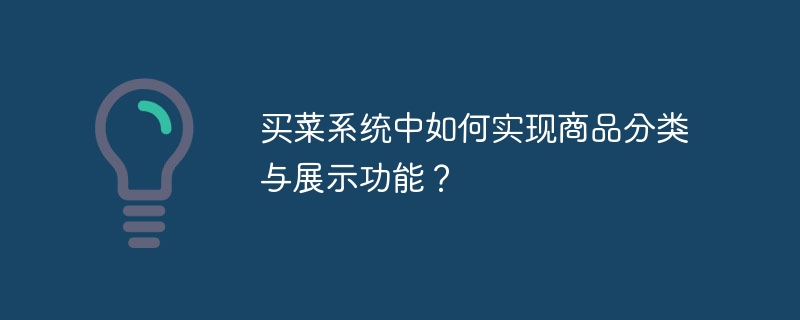

With the development of technology, online shopping has become a part of people’s lives. Especially in busy urban life, many people choose to buy ingredients and daily necessities through the grocery shopping system. The product classification and display function of the grocery shopping system is an important part of it, which can facilitate users to quickly find the products they need and achieve an efficient shopping experience.
First of all, the product classification function of the grocery shopping system should be clear and clear. By classifying various products, it can make it easier and faster for users to browse products. Common product categories include vegetables, fruits, meat, seafood, grains and oils, seasonings, daily necessities, etc. For each category, it can be further subdivided. For example, vegetables can be divided into leafy vegetables, roots, beans, etc. This classification method can make it easier for users to find the products they need and improve shopping efficiency.
Secondly, the product classification function of the grocery shopping system should be multi-level. Under each major category, subcategories can be further divided to better meet the needs of users. For example, the vegetable category can be further divided into subcategories such as leafy vegetables, roots, and beans. Users can select the corresponding subcategory to browse according to their own needs. Multi-level classification allows users to find the products they want more accurately and improves the shopping experience.
In addition, the product classification function of the grocery shopping system can also be combined with keyword search. Based on category browsing, users can search for desired products by entering keywords. For example, under the fruit category, users can enter "apple" to search for apple-related products. Keyword search can further improve users’ shopping efficiency, especially for needs for specific products.
On the basis of the product classification function, the food shopping system should also have a good product display function. Through clear product pictures and detailed product descriptions, users can better understand the characteristics and quality of the product. At the same time, the system can also provide information such as user reviews and ratings to help users make choices. Through the product display function, users can understand the products more intuitively and make more informed purchasing decisions.
The product classification and display functions of the grocery shopping system should also be combined with the personalized needs of users. The system can recommend relevant products to users by collecting users’ purchase history and preference information. At the same time, the system can also make intelligent adjustments based on users' purchasing behavior and feedback, providing product classification and display methods that are more in line with user needs.
To sum up, the product classification and display functions of the grocery shopping system are crucial to improving the user’s shopping experience. Clear product classifications can make it easier for users to find the products they need, and multi-level classifications can better meet user needs. Combined with functions such as keyword search and personalized recommendations, shopping efficiency and satisfaction can be further improved. Through good product display and detailed product information, users can better understand the product and make informed purchasing decisions. The grocery shopping system continues to improve product classification and display functions, which will bring users a more convenient and pleasant shopping experience.
The above is the detailed content of How to implement product classification and display functions in the grocery shopping system?. For more information, please follow other related articles on the PHP Chinese website!
 How to restore Bluetooth headset to binaural mode
How to restore Bluetooth headset to binaural mode
 What browser is edge?
What browser is edge?
 Win10 does not support the disk layout solution of Uefi firmware
Win10 does not support the disk layout solution of Uefi firmware
 How to use dict function in Python
How to use dict function in Python
 What are the differences between hibernate and mybatis
What are the differences between hibernate and mybatis
 What should I do if iis cannot start?
What should I do if iis cannot start?
 what does bbs mean
what does bbs mean
 Advantages and Disadvantages of Free Overseas Website Servers
Advantages and Disadvantages of Free Overseas Website Servers




